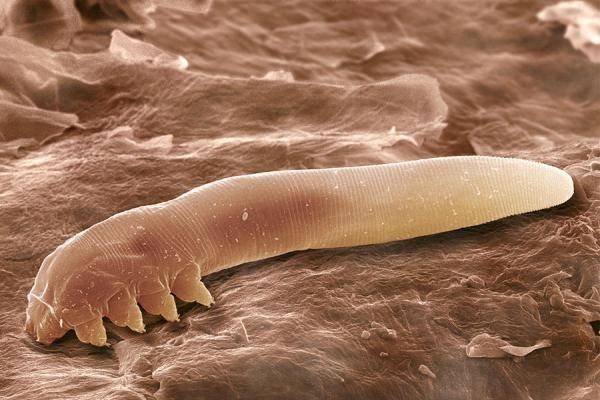The skin in dogs is much more sensitive than in humans. Therefore, what people feel after an insect bite does not compare with the sensations of our pets. Given that dogs are much more likely are attacked by bloodsucking parasites, this phenomenon can call them a real disaster. One of the parasites is subcutaneous tick in dogs or demodicosis, it is not only cause discomfort, but also the culprit of various diseases animal. Protecting pets is 100% impossible, therefore it’s better for dog owners to know what the parasite is and how it is fight.

Content
- 1. Demodecosis: basic information about the disease
- 2. Varieties of demodicosis in dogs
- 3. Symptoms of demodicosis in dogs
- 4. What to do if a dog is bitten by a tick
- 5. Treatment of demodicosis in dogs
Demodecosis: basic information about the disease
Contents
This is an invasive disease, in another way – iron, which cause endoparasitic mites localized inside the sebaceous glands, hair follicles, and also penetrate the internal organs.
A manifestation of demodicosis is skin dermatitis, hyperkeratosis (thickening of the stratum corneum of the epithelium), damage to internal tissues organs, general depletion of the body.
There are recorded cases of diagnosing the disease in 2-month-old puppies, but most often infection with a subcutaneous tick occurs in young dogs, from six months to two years of age.
The so-called “youthful” demodicosis is most often infected individuals of the following breeds:
- German shepherd dogs
- boxers;
- chihuahua;
- pit bull terriers;
- Pugs
- collie;
- Afghan hounds.
Tick affection is localized, i.e. it is affected only one part of the body, or generalized – when the tick spreads to various tissues and organs. Given the various degree of damage, there is no single prognosis for a cure.
With a localized form, damage is present on only one parts of the body, but there may be several sections. This type the disease is benign and the main symptom is hyperemia of the skin in the limbs or muzzle. If the disease is accompanied by an infection of a bacterial origin, suppuration or dry patches may occur skin.

With this degree of the disease, the prognosis is quite favorable. IN 90% of cases of the disease there is a sudden remission for a period of three weeks to two months, regardless of which used therapy. In other cases, demodicosis in dogs grows into a more complex – generalized form. Exists breeds prone to this particular subcutaneous lesion tick:
- boxer;
- dachshund;
- Shih Tzu
- Dalmatian
- shar pei.
There are a number of factors that contribute to the fact that a localized form of the disease spilled into a generalized:
- genetic addiction;
- the state of the immune system;
- the presence of diseases associated with the endocrine system. (Syndrome Cushing, Oncology, etc.)
In this situation, forecasting is difficult, often relapse of the disease. Only in 50% of cases do dogs recover without the use of special therapy. But only on condition that secondary infection suppresses immune mechanisms.
Pets with a reduced tick are more likely to get sick the body’s resistance to infections, at risk are as follows breeds:
- dwarf pinchers;
- chihuahua;
- toy terriers;
- dachshunds
- boxers and others
Often infected young individuals with immunodeficiency. The disease is transmitted by contact, when communicating with carriers parasite or sick animals. In addition, the dog may get infected through care products and various materials.
Varieties of Demodecosis in Dogs
Once on the skin of an animal, parasites can cause three species diseases:
- Scaly demodicosis – the main symptom of the disease – peeling of the skin surface. In this case, the risk increases. getting on the affected areas of pathogenic bacteria, which becomes the cause of a strong inflammatory process.
- Pustular demodicosis – observed on the skin small compacted nodules – pustules, their size does not exceed 3-4 mm Purulent exudate with putrid odor is released from pustules. Blood-purulent discharge dries on the skin of the pet, forming brown crusts. This type of disease requires a long therapy.
- Often, dogs develop both at the same time. forms of the disease, in this case the animal loses its appetite, since the tick is most often localized on the organs of the gastrointestinal tract.

Symptoms of demodicosis in dogs
In most cases, the subcutaneous tick first affects the area the dog’s head – eyebrows, lips, cheeks, then the neck, joints of the legs suffer, in the case of a generalized form, other parts of the body are affected. On localization of the parasite, the following is observed:
- the skin turns red, cracking, suppuration is formed;
- on the affected areas, hair falls out, bald patches form;
- itching may be absent or may be weak, therefore, with sometimes the dog doesn’t itch, but it can lick places bites; but if he does eat, the animal will itch constantly;
- the pus released from the pustules smells of rot;
- the dog can chill even in hot weather, as with the disease is disturbed by thermoregulation.
Initially small lesions over time significantly are increasing. All inflamed surfaces lose their coat. cover. Naturally, the disease also affects the behavior of the dog, the pet becomes lethargic, irritable, tries to avoid communication even with his master.

What to do if a dog is bitten by a tick
Of course, all the owners are interested in the question, is it possible remove parasite by itself? The answer is no, and not even worth trying to do it. Ticks penetrate the hair follicles and glands, and there are a great many of them on the body of an animal.
Every dog owner should know what to do and how to behave. correctly lead in this case:
- Firstly, do not try to treat the pet yourself, so how even an experienced vet is not so easy to diagnose subcutaneous tick. Therefore, as soon as the foci were detected defeat, you must immediately deliver the animal to the clinic.
- Secondly, it is necessary to facilitate the specialist’s task by preparing detailed history – sex, age of the pet, from what and when vaccinated, what illnesses suffered, are there allergic reactions.
- Thirdly, before visiting the clinic, do not use any external remedies trying to eliminate the symptoms of the disease – itching, pain, etc. Since the doctor, first of all, takes an analysis – scraping with affected areas.
Let the owners not be afraid, the procedure will not deliver unpleasant sensations to the pet. Veterinarian pinches a section of skin between large and index finger, presses to remove the parasite from hair follicle. After received the material carefully is being studied.
Ticks are often found in healthy dogs. If scraping analysis revealed one or two parasites, the analysis is taken again. For identifying concomitant diseases in the animal are taken for analysis and other biomaterials – blood and urine for general analysis, feces. An ultrasound examination is mandatory.
Dog Demodecosis Treatment
A complex conservative is prescribed for the treatment of the disease. therapy, which has two directions:
- Elimination of parasitic insects.
- Normalization of the immune system of the diseased body pet.
Often used drugs with acaricidal action – Ivomek, Iversect, Amitrazin, Ivermek. These tools can eliminate ticks from all surfaces of the body.

It is recommended to treat the affected areas with antiseptic preparations – Fucorcin (Castellani solution), Furacilin solution or salicylic acid, and then apply external acaricidal funds – Amitan, Amitraz, Ivermectin, Acarabor.
Treatment also requires careful cleaning not only of the place where the dog is sleeping, but the whole house. Parasitic insects can not stand cleanliness and use of disinfectants, therefore risks reinfection in your own animal house will approach zero.
Do not treat your favorite pet yourself, as demodicosis has similar symptoms accompanying another the disease is otodectosis. In the second case, the lesion causes an ear mite. Demodecosis is extremely rarely localized in the auricles, then, how an ear tick affects them. Despite the same the origin of the ailments – they are both provoked by parasites, treatment is different ones. When conducting therapy that is not appropriate for the disease, you can not only not achieve positive dynamics, but also significantly harm your pet.






